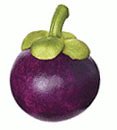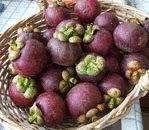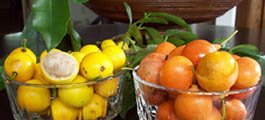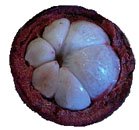Mangosteen Nutrition facts
Unique for its appearance and flavor, mangosteen is often revered as "the Queen" of tropical fruits, particularly in the Southeast Asian regions. This exotic, round, purple color fruit is quite popular for its snow-white, juicy, delicious arils all over Asian countries, and in recent years by European and American fruit lovers as well!
Botanically, it is the fruit belonging to the family of Clusiaceae, in the genus: Garcinia.
Scientific name: Garcinia mangostana. Known as "Mangkhud- (มังคุด)" in the Thai language, Thailand is the largest producer and exporter of mangosteens.

|

|
| Purple mangosteen. (Garcinia Mangostana). Note deep purple fruit with light green calyx. | Fresh fruits in the market. Photo courtesy: goosmurf. |
Mangosteen plant is an evergreen, upright tree reaching about 20- 60 ft in height. It is commonly found in tropical rainforests of Indonesia, Malaysia, Thailand, and the Philippines, as well as in some cultivated orchards of Sri Lanka and India, where annual precipitation and relative humidity are favorable for its growth. Fresh purple fruits can be available in the markets from June until October.
Each tree bears several deep-purple, round-shaped fruits capped with light green calyx at the stem end. Completely matured fruit measures about 3-7 cm in diameter. Its tough outer rind is about 7-12 mm thick which contains bitter yellow latex that stains clothes black.
Internally; it features 4 to 10 juicy, snow-white, soft, fleshy, triangular segments as in oranges. Each segment may carry 1-4 off-white colored seeds. Seeds are inedible and bitter in taste. The flavor of the fruit can be best described as sweet, mildly tangy, fragrant, and delicious.
 |
| Lemon-drop, and African mangosteens (Imbe). The fruits are smaller than the purple ones. Photo: I like plants |
Different species of Garcinia grown all around Southeast Asia, Africa, and South America all along the tropical belt. Cherapu or Button mangosteen (Garcinia prainiana) is native to Malaysia. It features a somewhat flat, mandarin orange-like shape with a thin rind that can be peeled very easily by hand, again as in oranges.
Lemon drop mangosteens (Garcinia madruno) are small size (2-4 cm diameter) fruits, native to the Malayan peninsula.
African mangosteen or Imbe (Garcinia livingstonei) is native to West Africa. They are slightly larger than the lemon drop type.
Health benefits of Mangosteen
Delicious and juicy, mangosteen is one of the popular tropical fruits. It comprises an impressive list of essential nutrients required for normal growth and development and overall nutritional well-being.
It is moderately low in calories (73 calories per 100 g) and contains no saturated fats or cholesterol. Nonetheless, it is rich in dietary fiber (100 g provides about 13% of RDA), essential vitamins, and minerals.
Mangosteen is good source of vitamin-C and provides about 12% of RDA per 100 g. Vitamin-C is a powerful water-soluble antioxidant. Consumption of fruits rich in vitamin-C helps the human body develop resistance to combat viral flu and help scavenge harmful, pro-inflammatory free-radicals.
Fresh fruit is a mild source of B-complex vitamins such as thiamin, niacin, and folates. These vitamins are acting as cofactors the help body metabolizes carbohydrates, protein, and fats.
Further, it also contains a modest amount of minerals like copper, manganese, and magnesium. Potassium is an important component of cell and body fluids and helps control heart rate and blood pressure, and thus, it offers protection against stroke and coronary heart diseases.
| Principle | Nutrient Value | Percent of RDA |
|---|---|---|
| Energy | 73 Kcal | 3.5% |
| Carbohydrates | 17.91 g | 14% |
| Protein | 0.41 g | 1% |
| Total Fat | 0.58 g | 3% |
| Cholesterol | 0 mg | 0% |
| Dietary Fiber | 1.8 g | 4.5% |
| Vitamins | ||
| Folates | 31 µg | 8% |
| Niacin | 0.286 mg | 2% |
| Pantothenic acid | 0.032 mg | <1% |
| Pyridoxine | 0.041 mg | 3% |
| Riboflavin | 0.054 mg | 4% |
| Thiamin | 0.054 mg | 4.5% |
| Vitamin A | 35 IU | 1% |
| Vitamin C | 2.9 mg | 5% |
| Electrolytes | ||
| Sodium | 7 mg | 0.5% |
| Potassium | 48 mg | 1% |
| Minerals | ||
| Calcium | 12 mg | 1.2% |
| Copper | 0.069 mg | 7% |
| Iron | 0.30 mg | 4% |
| Magnesium | 13 mg | 3% |
| Manganese | 0.10 mg | 4% |
| Phosphorus | 9.21 mg | 1% |
| Zinc | 0.21 mg | 2% |
Selection and Storage
Mangosteens are available fresh during the summer months. Fully mature deep-purple fruits are either hand-picked carefully or using a hook-and-basketing method as in mangoes and handled with care. Injury to the outer skin results in the percolation of bitter latex into the edible flesh turning the whole fruit bitter and inedible.
Mangosteen is now readily available in supermarkets across the United States. While buying, look for fresh fruits that feel heavy in hand with firm green calyx at the stem end and smooth, bright-purple outer surface, a sign that signals their fresh arrival from East Asian orchards. Avoid those appearing dry and blotched skins as they may be an indication of old stock.
At home, place ripe fruits in a cool well-ventilated place where they keep well for up to two weeks. For extended keeping quality, store them in the refrigerator.
Preparation and Serving tips
Wash them in water to remove any surface dirt. Fresh fruit has a thick, leathery, soft rind, quite like in pomegranate but a bit thicker. In general, the fruit is scored through the rind around an equatorial circumferential fashion using a paring knife, and its upper half is pulled up gently using the thumb to unveil sweet, snow-white arils inside.
Prolonged exposure to hot conditions may cause its outer rind to dry, and brittle, and may pose problems while peeling it.
 |
| Interior; mangosteen. Note for the snow-white segments (arils). |
Here are some serving tips:
Fresh mangosteens are wonderfully delicious. Enjoy this exotic juicy fruit all alone without any additions.
The fruit segments complement well with other fruit sections like papaya, watermelon, pineapple, grapes, etc.
Mangosteen juice is a refreshing thirst-quenching cool drink to beat the summer heat.
Mangosteen clafouti prepared using cornflour, and coconut milk is a delicious dessert.
≻≻-Back to Fruits from Mangosteen. Visit here for an impressive list of all varieties of fruits with complete illustrations of their nutrition facts and health benefits.
≻≻-Back to Home page.
Further reading and Resources:
Stanford School of Medicine Cancer information Page-Nutrition to Reduce Cancer Risk.